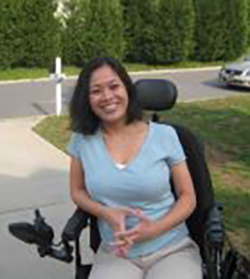THE DYSFERLINOPATHY JOURNEY
Individual Stories
THE DYSFERLINOPATHY JOURNEY
Individual Stories
Home ❯ Patients/Clinicians ❯ The Dysferlinopathy Journey ❯ Individual Stories ❯ Chanry
Chanry

One day, I noticed I had a slight limp. There hadn’t been an accident or fall. By the end of the week, my feet began to hurt (regardless of the shoes I wore). The following week, I stopped at a park to walk/run; half way through, my legs were unusually tired. A couple days later, I reached for something in the cabinet and realized I couldn’t tiptoe… my feet remained flat on the floor. Something was wrong.
The doctor didn’t find anything broken or fractured. He told me to take some ibuprofen and take it easy. The symptoms continued and worsened. Then, he referred me to an orthopedist. The orthopedist diagnosed me with flat feet and prescribed custom arch supports. Months passed and still no improvement. The limping had become more pronounced, and I’d lost the ability to run. I continued to experience progressive weakness in my legs, and noticed my calves decreasing in size. The only physical pain was on the bottom of my feet (not painful to the touch, but only when I was walking and/or standing). It was more difficult to go up steps than to go down. A friend mentioned that my limp looked different compared to when I’d hurt myself. I observed (in the mirror) my movement, and noticed my hip/pelvic area was shifting/moving in an awkward motion.
Not getting results with the current orthopedist, a friend referred me to another orthopedist. After testing and examining me, he said it appeared to be neurological and/or muscular, not orthopedic. He stated that flat feet weren’t the problem. Then, I was tested and examined by a neurologist. The first EMG and blood tests were performed. He said it was neurological and/or muscular, but couldn’t make a diagnosis yet. I continued with another neurologist from the same practice, but closer by. Again, the previous tests and exams were repeated, with the addition of a hair and nail analysis for toxins, lengthy health questionnaires, and a muscle biopsy (in my upper left arm). He diagnosed me with Polymyositis and started me on prednisone. Initially, there was a slight improvement, but it was very temporary. He then referred me to a rheumatologist.
Along with repeating previous tests, the rheumatologist ordered a bone density and heart tests. He prescribed new medications, while weaning me off the prednisone. After months, and no signs of improvement, he believed it was not Polymyositis, and referred me back to the neurologist. The previous neurologist had left. The new doctor reviewed everything and wasn’t sure where to go next. He didn’t feel it was necessary to repeat all the tests, as the results would probably be the same. He referred me to another neurologist. The new neurologist repeated every single test and exam. This time, the muscle biopsy was on my right calf. February 24, 1995, I was diagnosed with Miyoshi Myopathy, with no treatment or cure. I was the first case the doctor and his colleague had seen and diagnosed. At the time, they said there were about 40 recorded cases.
Shortly after, I registered with the Muscular Dystrophy Association (MDA) and I have been treated at the MDA clinics since 1995 to present. The disease continued progressing and also started to affect the upper body (a year after the diagnosis). The physical limitations continue to increase as muscles in the arms, legs, and other parts of the body atrophy and weaken. My physical independence was disappearing.
Several times, MDA doctors said my physical symptoms and progression looked like that of Limb Girdle. A muscle biopsy would be necessary to make that determination. I didn’t pursue it, as to not subject myself to another surgical procedure, when there wasn’t a treatment or cure.
Recently (2009-2010), I underwent some blood tests to determine an accurate diagnosis. They confirmed a diagnosis of Limb Girdle Type 2B (LGMD2B), dysferlin deficiency. It was explained to me that this disease is caused by mutations in the dysferlin gene, and I have the genetic defects from one of two ways: 1) inheriting the recessive genes from both parents (a 25% chance) or 2) from sporadic mutations. Though registered with MDA, I feel it is also beneficial to be registered with the Jain Foundation, as their focus is on finding a cure for LGMD2B/Miyoshi.
Currently (2011), I cannot: get myself up from a seated position or fall, lower myself onto a seat, go up or down steps, bend down, reach higher than my shoulders, lift and carry things, prevent myself from falling, or maintain my balance. But, I still walk in the home with the aid of a rolling walker and use a power wheelchair outside the home. Since the onset of the first symptoms in the summer of 1992, the muscles have atrophied tremendously, and the weakness continues to increase.
